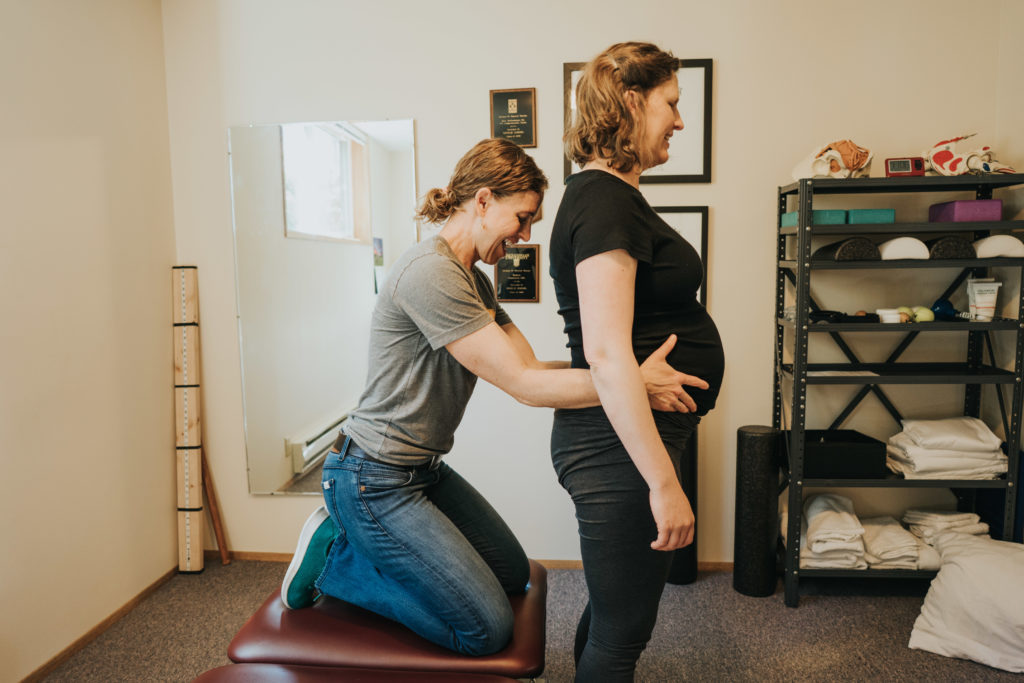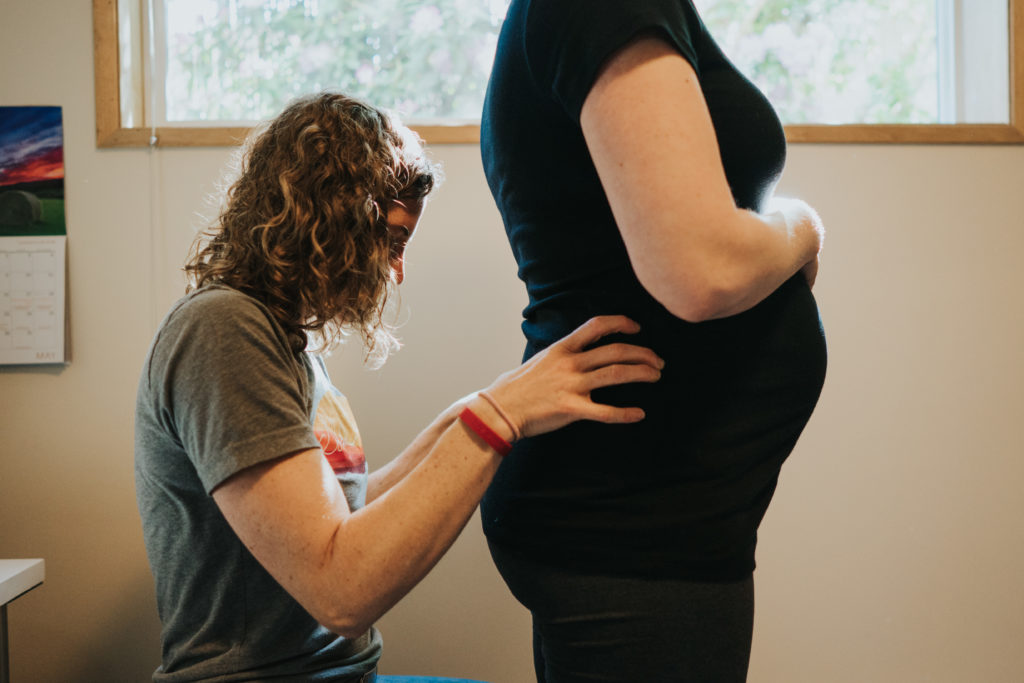
We are so excited to partner with Om Mama Collective member, Nicole, for our upcoming workshop: Training for Labor and Delivery on September 5th! 7:00-9:00pm at Nicole’s office, 4839 S. Brandon St, Seattle, WA, 98118. Free for Om Mama Members, $15 non-member pricing. Additional details, tickets & registration can be found here!
Here’s how to have your first, smoothest, and/or happiest labor!
How long is labor?
The average labor is 8 – 18 hours, but it’s really not about quantity it’s about quality so let’s move on.
How long does it take to train for labor?
The ideal training program is 9 – 12 months long. Don’t be discouraged though! Even if you only have a few weeks (or even days) left to train you can still significantly impact your labor by starting training now.
Exercise during pregnancy is about training for labor; an event that will require endurance, strength, patience, grit, flexibility, softness, and stamina. Just like any physical endeavor, the better trained you are the more you will enjoy the experience. The more physically and mentally prepared you are the more likely you are to be happy with your labor and to recover with greater efficiency.

Why do I need a labor training plan?
The body that you bring to pregnancy is the body that you bring to labor, make sure it’s ready!
That incredible body of yours that is growing a human life has a history to it. If you stop for a moment and think about it, your body has been through a lot. Perhaps you are or have been an athlete. You’ve had injuries from your sport, maybe they were big or maybe they were small. Perhaps you’ve been in a car accident. Perhaps you’ve had your appendix removed, had an abdominal surgery, or a cesarean section. Maybe you have endometriosis, gastrointestinal (GI) distress, or painful menstrual cycles. Perhaps this isn’t your first pregnancy.
You have had an awesome life and your body is a road map of where you have been and what you have done. This map is your story and it proves that the human body is capable of incredible adaptation and perseverance. However, when it comes time to have a baby sometimes this adaptation can get in the way of having the child birth experience that you want. That’s where the training comes in!
How do I know what type of training plan to follow?
The key component to any labor training plan is that it is a training plan for labor. A labor training plan should include education about what is happening to your body during labor and is focused on movements and exercises that support a laboring body.
This is an important distinction. There are many types of fitness programs for pregnant women that are more focused on keeping you in shape and assisting you to not gain too much weight. These programs can be good, but it’s important to understand the goals of any given fitness program. If you do choose one of these training plans, make sure you understand how to protect your loosening joints (thank you hormones) and avoid any exercises that create doming of your abdominal muscles (diastasis, no thank you).
Interested in learning more about a training program for labor? You’re in luck! Check out the group training program offered by SolMamas. Session 1 is launching on July 7th. 10% discount offered to Om Mama members.

What type of professional is best suited to provide me with a training plan for labor?
Physical therapists who have specific training in pregnancy and pelvic health are your best choice.
Members of Om Mama have unique access to three (and growing!) physical therapists who are developing individual labor training plans; Nicole Bulow of SolFuel Wellness, Allison Feldt of Body Motion Physical Therapy, and Sam of Emerald PT & Pilates.
Which type of program is best for first time pregnancies?
Any program that is training you for labor is perfect for first time pregnancies. With a first-time pregnancy the educational component of the program is even more critical so make sure this is a part of your training program.
I’ve already had one baby; do I still need to train for my labor?
Yes! Yes! Yes! Your body has changed as a result of previous pregnancies and deliveries. Remember that road map we discussed? That map has been further changed by your last pregnancy and labor. Labor may be smoother the second (or third time) around as your body has done this before, but that still doesn’t mean that you don’t need to train.
What are the components of a good labor training plan?
A good labor training plan will address the following components;
- The pelvic floor – the pelvic floor is the stop light for birth. The tone in the pelvic floor both cues the baby to rotate and the pelvic outlet (the exit) to open. Too much tone can prevent the baby from turning all the way and can limit how much the pelvis can open to allow the baby to exit. The inability of the pelvic floor to relax can contribute to a more challenging and prolonged labor experience.
- The deep core – core work during pregnancy is not about strength, it’s about maintaining tone and neuromuscular control (the brain-body connection) of your deep core (diaphragm, pelvic floor, transverse abdominis and multifidi). This allows you to carry your baby more comfortably (think less back pain) and is a powerhouse for helping push/breathe that baby out!
- The mobility of the hips and pelvis – there is a hormone called relaxin that loosens up all your ligaments for birth. Unfortunately, relaxin isn’t magic and a joint with limited mobility won’t yield to it’s wonders. Your training program needs to include movements you can do to help improve the mobility of your hips and pelvis.
- Posture – the way your sit and stand impacts the position of your baby in your growing belly. This is especially important during the last month of pregnancy when we want the baby positioned in a good birthing position with their back facing out. When we sit in a slouched position gravity pulls the baby towards your back and can cause them to rotate in the opposite direction.
Are there ways I can start training for labor right now?
Yes!
1. Make postural changes now … sit on your pelvic floor and avoid slouching
2. Train your diaphragm and pelvic floor to relax (and contract just a little bit)
Coordinated diaphragm and pelvic floor movement
- Sit in a comfortable position (kneeling or on a blanket/yoga block – sitting on your pelvic floor)
- Eyes open or closed
- Inhale – breathe into the sides and back of your rib cage
- Relax your abdomen, relax your pelvic floor (sit bones widen)
- Exhale – draw your pelvic floor up and in, abs pully gently in
- Inhale, fully relaxing. Exhale engage for 10 breaths.
3. Keep your deep core stabilizers working
Deep Core Strengthening – Hands and Knees
-
- Hands directly under shoulders, knees directly under hips
- Round and arch your back a few times to find a neutral spine.
- On an exhale – draw your pelvic floor up and in and draw your belly button towards your spine lifting your baby closer to your body
- Inhale and fully relax your belly letting the weight of your baby move away from you
- 10 times.
4. Improve the mobility of your hips and pelvis – move every day
Standing hip circles
- Stand with your feet wider then hip distance apart
- Circle your hips one direction 10 times, letting your trunk follow the movement of your hips
- Then circle your hips 10 times in the other direction
- Make the circles as big or as small as feels good to your body
5. Work with a physical therapist that specializes in the treatment of pregnant women!

Join us on September 5th to learn even more about how to plan & train for your birth!
 Photography by Om Mama Collective member, Alec Mills Photography
Photography by Om Mama Collective member, Alec Mills Photography






